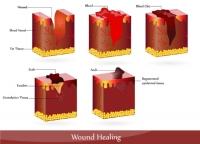The Benefits Of Micronutrients In Wound Healing
Everybody has experienced wounds either after an injury or surgery and most of the wounds heal naturally in an otherwise healthy person. A wound that does not heal or does not show signs of healing after two weeks is considered a slow-healing or a chronic wound and requires special care from a wound care facility to prevent infection and further complications and to accelerate the recovery process.
Chronic wounds are becoming a silent epidemic. It is estimated that about two percent of the population in developing countries will experience a chronic or a slow-healing wound at least once during their lifetime. If left untreated a chronic wound could lead to amputation of a limb, or other serious complications from widespread infection, and death. In the US alone, 6.5 million people are under treatment care for their chronic wounds and this number is expected to increase due to the aging population. According to current estimates, more than $25 billion is spent on treatment of chronic wounds every year.
Some of the factors that increase the chances of poor wound healing are obesity, stress, long-term immobility, a weak immune system, diabetes, and smoking and alcohol. Many pharmaceutical drugs including non steroidal anti inflammatory (NSAID) painkillers and steroids, are frequently prescribed during this phase and they also increase the chances of delayed would healing. Although most of these risk factors can be addressed by simple lifestyle changes hence reducing the chances of the development of chronic wounds, micronutrient supplementation should also be considered in treatment of this epidemic. It was proven in the early 20th century that the deficiency of micronutrients, especially vitamin C, considerably prolongs wound healing and the recovery process after surgery. Yet this knowledge is still not commonly used in today’s medical practice.
Metabolic requirements of the body increase significantly during the wound healing process and a preexisting deficiency of micronutrients will become more pronounced during this period. It has been observed that the vitamin C levels fall to severe scurvy levels in seriously injured patients during their recovery phase, indicating that micronutrient supplementation in much larger doses is required. The formation of new skin, muscles, bones and other connective tissue components is delayed without an additional supply of vitamin C. Collagen fibers are the building blocks of connective tissue and create the basic framework for regeneration. Formation of strong collagen requires a continuous supply of not only vitamin C, but other micronutrients working in synergy, including the amino acids lysine, proline, arginine, essential vitamins such as B, E, A, and minerals. Without these micronutrients, the replacement connective tissue that is formed between the cells and near the surface of the wound will be fragile, defective or missing altogether.
During the healing and recovery phase, our body utilizes micronutrients at a much higher amount than otherwise; however, this is the most neglected area of treatment and care of chronic wounds. A simple measure of additional supplementation may hasten the recovery process to repair cuts, burns, fractures and surgically damaged tissues without expensive treatments which include pharmaceutical drugs with their added side effects.
